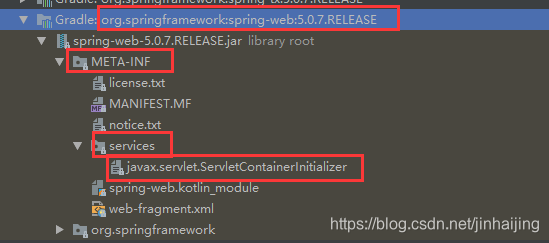idea中原生Servlet3.0開發之---使用配置類和註解的方式整合SpringMVC
以註解方式來啟動SpringMVC前需瞭解的基礎知識:
1、web容器在啟動的時候,會掃描每個jar包下的META-INF/services/javax.servlet.ServletContainerInitializer

2、載入這個檔案指定的類SpringServletContainerInitializer

3、spring的應用一啟動會載入感興趣的WebApplicationInitializer介面的下的所有元件;

4、並且為WebApplicationInitializer元件建立物件(元件不是介面,不是抽象類)
1)、AbstractContextLoaderInitializer:建立根容器;createRootApplicationContext();
2)、AbstractDispatcherServletInitializer:
建立一個web的ioc容器;createServletApplicationContext();
建立了DispatcherServlet;createDispatcherServlet();
將建立的DispatcherServlet新增到ServletContext中;
getServletMappings();
3)、AbstractAnnotationConfigDispatcherServletInitializer:註解方式配置的DispatcherServlet初始化器
建立根容器:createRootApplicationContext()
getRootConfigClasses();傳入一個配置類
建立web的ioc容器: createServletApplicationContext();
獲取配置類;getServletConfigClasses();
===========================
總結:
以註解方式來啟動SpringMVC;繼承AbstractAnnotationConfigDispatcherServletInitializer;
實現抽象方法指定DispatcherServlet的配置資訊;
===========================
定製SpringMVC;
1)、@EnableWebMvc:開啟SpringMVC定製配置功能;相當於web.xml中配置的 <mvc:annotation-driven/>;
2)、配置元件(檢視解析器、檢視對映、靜態資源對映、攔截器。。。)
extends WebMvcConfigurerAdapter
===========================
springmvc父子容器:
各自負責一些掃描的包
父容器:功能類的包,如:Controller,前端控制器,檢視解析器
子容器:業務模組的包,如:service,repositories,資料庫事物

使用配置類和註解的方式整合SpringMVC的例項步驟:
一、匯入servlet和springmvc的jar包
<project xmlns="http://maven.apache.org/POM/4.0.0" xmlns:xsi="http://www.w3.org/2001/XMLSchema-instance" xsi:schemaLocation="http://maven.apache.org/POM/4.0.0 http://maven.apache.org/xsd/maven-4.0.0.xsd"> <modelVersion>4.0.0</modelVersion> <groupId>com.atguigu</groupId> <artifactId>springmvc-annotation</artifactId> <version>0.0.1-SNAPSHOT</version> <packaging>war</packaging> <dependencies> <dependency> <groupId>org.springframework</groupId> <artifactId>spring-webmvc</artifactId> <version>4.3.11.RELEASE</version> </dependency> <dependency> <groupId>javax.servlet</groupId> <artifactId>servlet-api</artifactId> <version>3.0-alpha-1</version> <scope>provided</scope> </dependency> </dependencies> <build> <plugins> <plugin> <groupId>org.apache.maven.plugins</groupId> <artifactId>maven-war-plugin</artifactId> <version>2.4</version> <configuration> <failOnMissingWebXml>false</failOnMissingWebXml> </configuration> </plugin> </plugins> </build> </project>
二、建立MyWebAppInitializer .java相當於web.xml檔案
並繼承抽象類AbstractAnnotationConfigDispatcherServletInitializer(具體可看博文開始時描述)
此類相當於web.xml;載入spring和springmvc,並設定攔截
package com.atguigu;
import org.springframework.web.servlet.support.AbstractAnnotationConfigDispatcherServletInitializer;
import com.atguigu.config.AppConfig;
import com.atguigu.config.RootConfig;
//web容器啟動的時候建立物件;呼叫方法來初始化容器以前前端控制器
public class MyWebAppInitializer extends AbstractAnnotationConfigDispatcherServletInitializer {
//獲取根容器的配置類;(Spring的配置檔案) 父容器;
@Override
protected Class<?>[] getRootConfigClasses() {
// TODO Auto-generated method stub
return new Class<?>[]{RootConfig.class};
}
//獲取web容器的配置類(SpringMVC配置檔案) 子容器;
@Override
protected Class<?>[] getServletConfigClasses() {
// TODO Auto-generated method stub
return new Class<?>[]{AppConfig.class};
}
//獲取DispatcherServlet的對映資訊
// /:攔截所有請求(包括靜態資源(xx.js,xx.png)),但是不包括*.jsp;
// /*:攔截所有請求;連*.jsp頁面都攔截;jsp頁面是tomcat的jsp引擎解析的;
@Override
protected String[] getServletMappings() {
// TODO Auto-generated method stub
return new String[]{"/"};
}
}
三、建立spring的配置檔案RootConfig.java,即父容器
package com.atguigu.config;
import org.springframework.context.annotation.ComponentScan;
import org.springframework.context.annotation.ComponentScan.Filter;
import org.springframework.context.annotation.FilterType;
import org.springframework.stereotype.Controller;
//Spring的容器不掃描controller;父容器
@ComponentScan(value="com.atguigu",excludeFilters={
@Filter(type=FilterType.ANNOTATION,classes={Controller.class})
})
public class RootConfig {
}
四、建立springmvc的配置檔案AppConfig.java,即子容器
package com.atguigu.config;
import java.util.List;
import org.springframework.context.annotation.ComponentScan;
import org.springframework.context.annotation.ComponentScan.Filter;
import org.springframework.context.annotation.FilterType;
import org.springframework.stereotype.Controller;
//SpringMVC只掃描Controller;子容器
//useDefaultFilters=false 禁用預設的過濾規則;
@ComponentScan(value="com.atguigu",includeFilters={
@Filter(type=FilterType.ANNOTATION,classes={Controller.class})
},useDefaultFilters=false)
public class AppConfig {
}
五、 框架搭建好後,建立controller和service等業務程式碼,進行測試
HelloController.java
package com.atguigu.controller;
import org.springframework.beans.factory.annotation.Autowired;
import org.springframework.stereotype.Controller;
import org.springframework.web.bind.annotation.RequestMapping;
import org.springframework.web.bind.annotation.ResponseBody;
import com.atguigu.service.HelloService;
@Controller
public class HelloController {
@Autowired
HelloService helloService;
@ResponseBody
@RequestMapping("/hello")
public String hello(){
String hello = helloService.sayHello("tomcat..");
return hello;
}
}
HelloService.java
package com.atguigu.service;
import org.springframework.stereotype.Service;
@Service
public class HelloService {
public String sayHello(String name){
return "Hello "+name;
}
}
六、執行tomcat測試

說明:controller能訪問到,並且能呼叫service,說明springmvc配置成功
